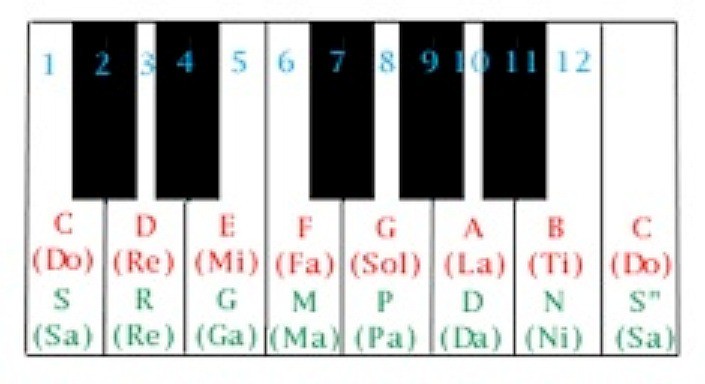60. A Gentle Introduction to South Indian Classical (Karnatic) Music 1/4

ACKNOWLEDGEMENTS
I owe a tremendous amount of gratitude to my music teachers, Prof. T. R. Subramaniam and Prof. Prabhakara Varma and to friends like Surya Prabha, Srikanth Chary and Prof. R. Pichumani (University of Connecticut) for teaching me the fundamentals. A big thanks to Ilayaraja (no, I dont know him personally) for many wonderful Karnatic music-based film songs, which presented an entirely different angle to Karnatic music. Finally, I owe it all to my friend K. S. Balaji for introducing me to Karnatic music.I am also fortunate to be friends with several folks who are very knowledgeable about music. I learnt a lot from them and many of them have been active on the music bboards one time or another. (Some are still active). A short list of these people includes Prof. S. Mahadevan and Monica (Vanderbilt University), Prof. Venkatasubramaniam and Vyju (Purdue), Mukund Srinivasan, Chandramouli (A. T and T), Prof. V. Krishnan (University of Texas), Srinivasan Gopalaswamy (Carnegie Mellon), Srinivasan Pichumani and Kannikeswaran. And it is always a pleasure to acknowledge how much I benefited from Rajan Parrikar and his immense knowledge of almost every aspect of Indian music.
WHAT IS THE FOCUS OF THIS PRIMER?
Many of us have grown up in India, where we were exposed to Indian classical music in one form or another. However, if you are not from a musically inclined family, the odds are that you perceived classical music to be something esoteric that only a selected few could understand and appreciate. An occassional devotional song or a 'classically tuned' film song would have made you stop and take note. Your curiosity could have been aroused. But, you may have quickly ignored the instinct and made a beeline for the usual pursuits in life. Even if you were interested enough to find out about classical music, you did not know what books to read or who to talk to. Even if you managed to talk to someone, it is likely that the person made you feel inadequate about your lack of musical abilities or proceeded to give you a long lecture about music with a million buzzwords that confused you and weaned you off your curiosity. It is unfortunate that there is an almost total lack of simple, readable, introductary texts on Indian classical music, especially when compared to volumes and volumes of elementary books available on Western Classical music. No wonder an average college-educated person in the USA is at least mildly knowledgeable about Western classical music whereas an average Indian is by and large ignorant about the technicalities of Indian classical music. This primer is a feeble attempt to introduce Karnatic music in a gentle way, in a language presumably we all can understand. I want to be able to rekindle your interest and help you discover some of the 'method' and grammar of Karnatic music. Even though these notes are aimed at introducing Karnatic music, a lot of of what I have to say also apply to Hindustani Classical music.This primer is obviously not meant for experts. I have intentionally kept this text simple. The idea is to introduce the richness of Karnatic music and not to write an encyclopedia. Some of what I will be saying may not be entirely accurate, but the simplicity is more important than dictionary definition of terms. This primer is only intended to get you started and once you are on your own, there are many, many texts you can refer to for all kinds of information. These notes are also not meant to be complete, because I will be using only a minimum of technical terms. I won't even attempt to discuss the 'vaadhi-vivaadhi -samvaadhi' kind of technicalities and lose my reader.
So, lets get started!
SOUND AND MUSIC
Music is an extremely subjective, aural experience. Some sounds are perceived by us as pleasant and some others as unpleasant. What is considered pleasant or unpleasant can be quite personal, based on our specific culture, exposure to particular kinds of music and perhaps even on what our parents told us. A song could be a major hit in one country and could be completely disliked and ignored in some other country. Our musical tastes are indeed developed. As we grow up, and discover music from other cultures or newer musical styles, our tastes too change. Sometimes, we even discover a pleasant piece of music purely by accident - because it simply happened to resonate with our inner sensibilities. Oh, nothing like self discovery !So how do we make sense of sound and music ? Let us try to answer this by examining some simple concepts first. Our high school physics tells us that sound has several features - such as pitch, intensity, quality and duration. The pitch is just the frequency of the sound vibration - given in hertz or cycles. The musical term for frequency is 'tone'. The audible frequency range extends from about 25 Hz to around eight or ten thousand hertz, although it depends entirely on the individual. Children can hear much higher frequencies. At the lower end of the range, even if we may not 'hear' ultralow frequencies, we may 'feel' the vibrations as a tactile sensation.
The intensity is the same as loudness and it is related to the amplitude of the sound wave. One should learn to not confuse the intensity with the frequency. For example, try to recite the nursery rhyme 'Baa baa black sheep, Have you any wool ?' When you come to the syllable 'bl' in the phrase 'black sheep' (or 'woo' in the word 'wool') you are hitting a higher 'tone' compared to 'Baa baa'. This is the effect of frequency. Now, you can either whisper this nursery rhyme or shout your guts out. In each case, you are simply changing the intensity.
The other attribute of sound - duration - is self-explanatory. It is simply the time during which the specific frequency or 'tone' lasts. The term 'quality' is more difficult to understand. It is simply a signature of the source of the sound. It is a term which explains why a violin sounds like a violin and a drum sounds like a drum. This attribute is precisely the reason you can make out your mother's voice over the phone even if she has a horrible cold. The bottomline is, when you or an instrument produce sound, you not only produce one frequency, but also produce a spectrum consisting of several 'overtones'. This is variously referred to as 'timbre' or 'tone color'. This constitutes the 'Quality' of that sound.
Just to explain this concept some more, let us say you try to produce a single frequency with your voice - one way to 'produce' a single frequency is to get a keyboard and keep pressing one of its keys and you hum along till you resonate. If you actually analyzed the waveform you produced, you will see not only a significant amount of the frequency you were trying to produce but also see small amounts of other frequencies - which are the overtones. The exact composition of overtones you produced is in some sense the signature of your voice and constitutes its quality.
This should also set you thinking. Just how in the world do you perceive sounds ? How do you identify your friend's voice ? Clearly you are not decomposing it into frequency components (Fourier analysis). How do you sometimes make out which song it is simply by listening to a few notes ? How is it that you can mentally 'visualize' (!) someone's voice, laughter, sounds, some past conversations, songs ? Basically, when you hear sounds and music, you are simply doing a 'pattern recognition' against what you already know. Over the years, your brain has stored a certain number of 'primitives' - this list is a dynamic one and primitives are added or lost as you grow older - and you have an intrinsic capability to match a freshly heard sound impulse to the basic database. If you hear a strange sound that does not produce a match, sometimes you load it up as a primitive.
An equally interesting exercise - think of five songs you really like. Can you explain why you like them or what is in common with all of them ? Can you 'explain' and define your musical taste ? Unfortunately, however much analysis one does, in terms of frequencies and so forth, it finally boils down to psychological factors when it comes to music and taste. Analysis is merely a tool to understand some of its structure. It can never explain why some musical sounds are deemed 'romantic' or 'harsh' or why some Ragam is an evening Ragam (if you believe in such things). Such mystique about music will come back to haunt us and will forever prevent us from understanding its totality in an objective manner.
This is just a simple stab at the psychology of sound perception. Let us get back to the business on hand!
WESTERN MUSIC, INDIAN MUSIC AND THE KEYBOARD
Let us examine the frequency aspect of music first. This is perhaps the most studied aspect as well. We mentioned that all music is produced in the audible frequency range, a range which varies from person to person. Although human ears cannot tell very high 'tones', musical instruments can produce frequencies (overtones) even beyond the threshold of human hearing. Music is sometimes described technically as 'tonal' or 'chromatic', both terms simply mean that we use a whole spectrum of frequencies to produce music.The audible range is divided into 'octaves'. An octave is really a frequency range from a frequency f1 to f2 such that f2 is twice that of f1 in terms of cycles or hertz. For some physiological reason, the human ear is logarithmic and is sensitive to frequency octaves. The audible frequency is then comprised of many, many octaves. We can choose any number to be our f1 (and f2 of course is 2 times f1) - we can define an octave from 10 Hz to 20 Hz or equally well another one, say from 15 Hz to 30 Hz.
In terms of sound production, a typical human voice can produce several frequencies, although it is usually limited to about three or four octaves - even if we have a drum-like, groggy 'morning voice' at the low end of the range and a shrill, ear-piercing shriek at the high end. Only the exceptionally gifted people can produce a wide spectrum of vocal sounds spanning several octaves. (Of course, there are those female Indian movie playback singers who can produce ultra high frequencies which only dogs can hear clearly !) By the way, here we are only talking about 'primary' frequencies and not overtones associated with the 'quality' of our voices - remember, overtones are higher frequency components, but produced in much lower intensities.
A piano or a keyboard is a typical Western musical instrument. All we see is a bunch of keys, some in black and some in white. However, upon a closer look, we see that there is a periodicity. As we go from the left of the keyboard to the right (and here I am assuming you know how to sit in front of a keyboard) the keys produce higher and higher frequencies. In fact, the key frequencies are arranged in such a manner that they are in a geometric series. That is, the frequency between any key and the key immediately to its left (irrespective of the color of the key) is a constant, the constant being equal to the twelfth root of two or 1.059. For example, typically, there is a white key in the keyboard set to 240 Hz. Then the adjacent key on the right, a black one as a matter of fact, is set to 240 X 1.059 = 254 Hertz.
By the specific choice of this ratio (twelfth root of two) we see that by the time we reached the thirteenth key, we have doubled our frequency and thus spanned a whole octave. In fact, if you look at the keyboard you see that the key pattern repeats every twelve keys. If you chose the white key at 240 Hz, then the thirteenth key will be at 480 Hz and your octave ranged from 240 to 480 Hz. Equally well, you could have started counting from the black key at 254 Hz and twelve keys later you would have still spanned an octave, except that this time your octave ranged from 254 to 508 Hz.
This division of the octave into twelve 'tones' which have specific ratio between adjacent keys (the ratio equalling 1.059) is peculiar to Western music. This geometric arrangement of frequencies of the keys in an octave is called an 'Equally tempered' arrangement. And besides the keyboard, most Western musical instruments are also tuned to such an arrangement.
Even though there is a degree of freedom about what you want to be the range of an octave (whether it is from 240 to 480 Hz or 254 to 508 Hz etc.) the Western music defines a standard octave called the 'Middle C octave' (also called the Middle C scale etc) starting from the white key set to 240 Hz. The entire octave (the twelve key pattern, that is) is shown in Fig. 1. On your keyboard, this octave is located somewhere near the middle. Once you figured out where this octave is, you can quickly identify the first key of this octave (set to 240 Hz). And because we know the ratio of the key frequencies now we can pretty much compute the frequency generated by ANY key. You will also notice that the keyboard has about three to four octaves (between 36 to 48 keys, depending on how much you paid for it) The upper octave, starting from 480 Hz is the Upper C octave and the lower octave starting at 120 Hz is the Lower C octave etc.

From Table I given below, we notice that the keys in the octave have labels for identification. Of the white keys - and there are seven of them in an octave - the first one is called C (and hence the name 'Middle C' octave) and then we progress alphabetically to G and then back to A and B, after which, the present octave ends and the C key of the next octave begins. The same labelling system is repeated for the keys in the other octaves as well. If you noticed, the five black keys have ambiguous labels, because each one of them has two labels. The first black key, for example, is called 'C sharp' (C #) or 'D flat' (Db) - it is obvious that 'sharpening' essentially is a technical term for being 'one key higher' and similarly 'flattening' is one key lower in frequency than the white key in the prefix. The labels, frequencies etc of all the twelve keys in the Middle C octave are provided in Table I.
Table I: Arrangement of keys in a keyboard
Key # Key color Frequency (Hz) Name
1 White 240 C
2 Black 254 C # (D b)
3 White 269 D
4 Black 285 D # (E b)
5 White 302 E
6 White 320 F
7 Black 338.5 F # (G b)
8 White 358.5 G
9 Black 380 G # (A b)
10 White 402 A
11 Black 426 A # (B b)
12 White 451 BNow here is a set of bizarre technical terms - by definition, each key is supposed to be a 'semitone' or 'half tone' apart from its adjacent key. Thus, keys which are second nearest neighbors are considered a 'whole tone' apart. (Note that the sense in which we use the word 'tone' here is quite different from our earlier usage of it to mean frequency). For example, the first white key ('C' key) and the first black key ('C sharp') are a 'semitone' apart, whereas the first white key ('C key') and the second white key ('D key') are a full tone (whole tone) apart. And the 'C sharp' and 'D' keys are a semitone apart, as well.
Yet another aside: All keyboards are not necessarily tuned to the middle C key (which is set to 240 Hz). You can build keyboards which have a different reference point. Fixing the middle A key to a particular frequency (440 Hz) is a common alternative.
You can play with the keys and produce music. The keys and the 'tones' they produce are the basic building blocks of music. You can even press the same key twice or stay on one key for an extended period of time. You will also notice that although some 'melodies' are pleasant to the senses, some other sequences are not. If it is the very first time you are tinkering with a keyboard, the odds are that whatever melody you produce sounds 'musical' to you and of course, extremely unpleasant to the others around you. If you increase the volume on the electric keyboard, you are changing the intensity. If you choose different 'instruments' the modern day keyboards simulate, you are then changing the 'quality'. Basically, you now know how to manipulate the essentials of music, namely the pitch, intensity, duration and quality.
Having said all this, we should also realize that there is nothing inherently scientific or sacred about this 'Equally tempered, twelve key per octave' Western music system, where an arbitrary set point is created at 240 Hz. There are other alternate systems and creative musicians are always experimenting with unconventional systems - in music it is 'cool' to break tradition ! For example, there is no need to have just twelve keys in an octave. In fact, the traditional Indian music system over thousands of years is based on a 22 key per octave system. Even if you chose twelve keys to fill in an octave, there is no reason to tune them in a geometric progression. In other words, you don't have to have an 'Equally tempered scale'. You can locate your frequencies based on some other non-geometric criteria which might 'sound' even better. Such scales in fact, exist and they are called 'Just tempered scales'. In fact, the Indian musical system uses one such scale. And in the final analysis, there is no need to even stick to the concept of octaves when producing music. In short, to produce music, there is no need for a grammar and rules ! If it sounds pleasnt, you are on. However, let us first learn the established grammar and tradition, before we attempt to break them!
Even though Indian musical systems are very different from the traditional Western Music system, we can still get a lot of insight into Indian music using the Equally tempered, twelve keys per octave methodology - essentially because it makes things simple. (Also, the keyboard is probably one of the easiest instruments to play). This has always been a bone of contention between the traditional Indian musicologists and the 'quick and dirty' folks like us. The Indian traditionalist will argue that we are compromising by limiting ourselves to just twelve 'tones' per octave, when tradition, dating back thousands of years, categorically spells out twenty two 'tones' per octave. The twenty two 'sruti' for the middle C octave is given in Table III. By the way, the Indian word for frequency or pitch or 'tone' is 'Sruti. A word of caution though - the term 'Sruti' has several other interpretations and meanings. We will come across some of them later.
Why, some Indian schools of thought even propose that there are infinite frequencies in an octave. The basic reason for such demands for more than twelve 'srutis' per octave is that Indian music, (not just Karnatic music) seems to 'flow' through the frequencies, whereas a Western song seems 'jumpy'. Take for example, 'Baa baa black sheep' and compare it to an Indian song, say, a movie song like 'Roop tera mastaana'. The Indian song seems to involve a lot of vocal acrobatics and nuances and not just go through piano-like jumps. This is the main difference between the Indian and Western music and we will return to this point again and again in this primer.
This is the reason why Indian classical music cannot be played effectively in a twelve key per octave instrument like a piano. Of course, several Western instruments have been 'adapted' with a little modification here and there, to play Indian classical music - violin, mandolin and guitar, for example. Some other instruments have been simply 'used', without modification, such as the harmonium and its latest cousin, the keyboard. Indian purists abhor such blatant use of Western, 'equally tempered' instruments. Expert harmonium player, Rajan Parrikar, points out that 'Just tempered' harmoniums, harmoniums with 22 tones per octave, even over 50 tones per octave etc have been built by various people.
Now let us come back to this basic difference between the Western and the Indian classical music system. We noted that in Indian music it is not enough to produce just twelve or even twenty two 'tones' in an octave. One ought to produce even the intermediate frequencies. These intermediate frequencies, which do not have any keys to produce them, are called 'microtones'. The Indian word for the 'microtone' is 'gamakam'. (of course, 'gamak' in hindi) It is often very difficult to explain this concept clearly and precisely. If the C key produces 240 Hz and the C# key produces 254 Hz what intermediate frequencies are we talking about ? Does Indian music use sounds produced at 247 Hz ? Treatises have been written in India about such microtonal apects of music. Suffice it to say that microtones or gamakams tend to be clustered around the primary key frequency, although this need not always be the case.
Note that if you postulate that an Indian music octave has twenty two or two hundred keys or infinity per octave, then what used to be a 'microtone' in a twelve-key system could now very well be a key. Of course, you can make a piano with such large number of tones per octave. It may be a long piano and you will need a superhuman dexterity to play it. But the positive side of it is that you will be able to play Indian music on it. The bottomline is, the piano produces just twelve frequencies in one octave and that is enough to compose a lot of Western songs. Whereas, to make Indian music, twelve keys are not enough in an octave.
Let us talk some more about microtones or gamakams. The vocal gliding and rolling in Indian music, (Remember Kishore Kumar's yodelling ?) whether it sounds good or not, are again examples of microtone usage. In fact, the microtones add variety to the Indian classical music - an extra dimension. From movie songs to folk music to classical music, the very heart of Indian music is this 'continuous flow' or 'gliding through a continuum of frequencies' or gamakam or microtonal excursions. Thus it is often said that Indian music is 'melody-based'. Since microtones are so important in Karnatic and Hindustani music and very few instruments can produce all the frequencies in an octave, the best enunciation of Indian classical music is in vocal singing. Many instruments like the violin, Gottuvadhyam (called Chitra Veena these days) and even the simple bamboo flute can produce a lot of gamakams, of course.
Just to drag the concept a little farther - some of you who have grown up in India may have developed a taste for Indian music, be it movie songs or highly classical songs. When you were exposed to Western rock and roll music you may have been drawn toward the numbers rich in gamakams (The Beatles, Simon and Garfunkel et al have produced many such pieces) rather than the rhythm oriented heavy metal numbers.
In the same breath, people say that the Western music is 'harmony-based', which brings out yet another difference between the two systems. 'Harmony' is produced when several instruments play different melodies or pieces simultaneously like in an orchestra. Harmony is also produced when more than one tone is produced at the same time. In the Western Music, 'harmony' is an important element.
Orchestration and 'harmony' are absent in Indian classical music. People have tried out orchestration of Indian classical music time and time again with limited success. (and there have been probably as many Western attempts to compose and play 'Indian style' melody based classical music) There is not much of a market for such 'Fusion' music, except perhaps among the fringe elements of the immigrant Indian community :-) Even if there is a 'Jugal bandhi' - a standard fare in Hindustani classical music where two instruments (or even two vocalists) are featured together, the musicians usually follow the same melodic pattern one after another with minor variation rather than play different melodies simultaneously.
There are a number of other differences as well between the two systems of music. Indian classical music, for example, does not use what are called chords, or pressing more than one key simultaneously. Chords are a major aspect of Western music and producing harmony via chords is a natural consequence of the Equally tempered (geometric series) arrangement of the keys. If keys were arranged in a Just tempered sequence, pressing more than one key at a given time might produce an unpleasant sound pattern resulting in what is called 'Besur' (in Hindustani music) or 'Abaswaram' (in Karnatic music). By the way, one more advantage of Equal temperment of pianos and keyboards is that it makes it easier to 'tune' them, (they go out of tune every once in a while and need to be tuned periodically) since each key is harmonically related to the other keys. In case of Just tempered arrangement, since the key ratio between adjacent keys is not a constant, most keys will have to be tuned individually.
Also absent is 'polyphony' - where several instruments (melodies) come and go asynchronously instead of at periodically predictable times. Also, the Western scales are standardized. The middle C octave ranges from 240 to 480 Hz. There is no reason to stick to these frequencies. In fact, in Indian music, you have the freedom to choose the frequency range of the octave from anywhere to twice anywhere. You can start at 230 Hz, if you wish. Also, in Western classical music, most musicians have music notated on sheets of paper and 'read' it when performing. Indian music is always played by 'ear'.
Just to summarize, the essential differences between Indian classical music system and the Western music are (a) the Western keyboard is 'Equally tempered' whereas the Indian keyboard ideally should be 'Just tempered' (b) Only twelve keys per octave are used in the West, whereas to play Indian music one needs to produce several intermediate microtones, not represented by a conventional keyboard - This is the most major difference (c) Harmony, chords, polyphony etc are absent in Indian classical music (d) In Indian music, there is no need to standardize an octave to begin at 240 Hz.
We have enunciated again and again that we need many, many microtones to produce Indian music. Still, in this chapter, we are going to use a conventional, Western keyboard to learn about Indian music. It is almost like the Indian music is an analog entity and we are trying to quantize or digitize it into twelve keys, knowing fully well that we will have something akin to truncation (approximation) errors.
But before we begin, let us define one more term - the 'note'. The 'note' is just a primitive element of a musical phrase. An analogy will be the concept of a 'syllable' in a spoken word or a letter in a written word.
For example, in the nursery rhyme 'Baa baa black sheep' there are four 'notes', namely 'baa', 'baa', 'black' and 'sheep'. By a curious coincidence, this line also has four syllables - and we have managed to make a 'note' for each syllable. The concept of a note is so simple that even if you know nothing about music, you may be able to tell how many notes there are in a (simple) melodic pattern.
On the other hand, consider 'Roop tera mastana, pyaar meraa...' When spoken, the word 'roop' has only one syllable. However, when sung, it is distorted to sound like 'roo - pu' and uses TWO 'notes'. Similarly, when the singer goes 'pyaar meraaaa', he glides the end of the word 'meraaaa' into several 'notes'. The term 'note' and 'tone' are different and make sure you understand it. The word 'tone' is essentially a frequency, whereas the 'note' is the smallest part of a melody and could last one 'tone' plus possible microtones. The Indian word for 'note' is 'Swaram' or 'sur'. Now we are ready to get more technical and tinker with any commercially available keyboard to learn about Indian classical music. A diagram showing a typical keyboard octave is given in Table II, except that now we have labeled the keys with Indian names. Onceagain, eight out of the twelve keys have unique labels, whereas four of the remaining keys - keys 3, 4, 10 and 11 - have ambiguous (two possible) names. Unlike the Western notation, the keys with ambiguous labels are both black and white (two of each).
In the Indian system, we do not use alphabets to label keys. Instead, we use short, meaningless (please don't beat me to death on this - I know there are etymological reasons for choosing these set of syllables) syllables which go - Sa ri ga ma pa dha ni. These seven syllables are actually mnemonics to represent the 'notes' or 'Swarams' in Indian music. They are referred to as the 'Saptha Swarams' or 'Seven Swarams'. So, confusing as it may sound, in Indian music, we use the 'notes' to represent the 'tones'. Upon looking at Table II some more, we see that some THREE keys can be designated as 'ri', (even though they are designated as ri 1, ri 2 etc, they are all 'called' ri) three keys as 'ga', two as 'ma', three as 'dha' and three as 'ni'. However, there is no ambiguity when we want to press the keys corresponding to 'Sa' or 'Pa' - they are unique.
This notation (and this set of seven 'notes') is also called the 'Solfege notation' (in the West). Remember, even in the West, there is a solfege notation which goes do, re, me, soh etc. Basically, the solfege notation is a 'singable' set of syllables which helps us describe a musical melody. It will sound quite ridiculous to sing out words like 'C, C sharp, E flat' - instead of 'do fa la' when we hit the keyboard keys.
(An aside: The complete names of the Indian notation are as follows: Shadjam for Sa, Rishabham for ri, Gandhaaram for ga, Madhyamam for Ma, Panchamam for pa, Dhaivatam for dha and Nishaadham for ni - This information is provided just so that you don't get too zapped when someone uses these full names)
Even in case of Indian music, we can extend our labeling of the keys to other octaves, much like in the Western system. In Indian music, the main octave is called 'Madhya stayi', the octave above it (higher) is called 'tara stayi' and the octave just below the Madhya stayi is called 'Mandra stayi' (based on the way 'mantras' were chanted in low frequencies in the centuries past). In terms of notation, the keys in the higher octave are labeled with a dot on TOP of the notes. The keys in the Mandra (lower) stayi are identified with dots BELOW the solfege notes.
Many good Indian musicians have voices spanning the entire three octaves, although most Indian compositions use up just the complete Madhya stayi scale and the top half of the Mandra stayi (only half an octave below) and the bottom half of the Tara stayi (just half an octave above the Madhya stayi).
We also see that the twelve keys of the octave divide into two halves. The four keys which are designated as ri and ga are called the 'bottom tetrachord' (in Indian terminology, 'Poorvaangam') and similarly the four keys corresponding to dha and ni are called the 'upper tetrachord' or 'Uttaraangam'. There is some kind of a symmetry between the bottom and the top tetrachords and key label assignment.
Just when you thought you had seen enough of the buzzwords, here is one more ! The starting frequency of your personalized octave relative to a 'standard' octave determines the 'pitch' of your voice. Your signature 'pitch' or 'sruti' (here we are using the word 'sruti' to mean 'the starting frequency of 'your' octave') is measured in a weird sounding unit called 'kattai'. Half a 'kattai' is a semitone and a full kattai is a 'whole tone'. If your octave happens to start at 240 Hz then you have a 'four kattai sruti', by definition. If your voice is very low pitched then you can have lower than four kattai as in case of many males. Women and children are high pitched and can have higher than four (even six) kattai srutis and their octave will start at frequencies higher than 240 Hz. An approximate Western equivalent of this is called 'Register'. In Indian classical music, the octaves are 'free floating', varying from person to person. The starting points are not pegged at 240 Hz.
Table II: Karnatic names for keys in a keyboard
Key # Western name Karnatic Karnatic
(Notation 1) (Notation 2)
1 C Sa S
2 C # (D b) Ri 1 R1
3 D Ri 2 (Ga 1) R2 (G1)
4 D # (E b) Ri 3 (Ga 2) R3 (G2)
5 E Ga 3 G3
6 F Ma 1 M1
7 F # (G b) Ma 2 M2
8 G Pa P1
9 G # (A b) Dha 1 D1
10 A Dha 2 (Ni 1) D2 (N1)
11 A # (B b) Dha 3 (Ni 2) D3 (N2)
12 B Ni 3 N3It is also common to abbreviate the seven notes sa, ri, ga, ma, pa, dha, ni to letters S, R, G, M, P, D and N. The way to use this table is to realize that when you hit the first key of the octave (the C key) you will sing out 'Sa'. When you hit the first black key (C sharp) you will sing out 'Ri'. On the third key, you will sing out 'Ri' or perhaps a 'Ga' depending on the context. More about this 'context' later.
Table III: 22 Sruti scheme
Sruti Frequency Frequency
ratio (Hertz)
Sa 1 240
Ri 1 32/31 252.8
Ri 2 16/15 256
Ri 3 10/9 266.6
Ri 4 9/8 270
Ga 1 32/27 284.4
Ga 2 6/5 288
Ga 3 5/4 300
Ga 4 81/64 303.7
Ma 1 4/3 320
Ma 2 27/20 324
Ma 3 45/32 337.5
Ma 4 64/45 341.3
Pa 3/2 360
Dha 1 128/81 379
Dha 2 8/5 384
Dha 3 5/3 400
Dha 4 27/16 405
Ni 1 16/9 426.6
Ni 2 9/5 432
Ni 3 15/8 450
Ni 4 31/16 465

























